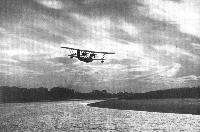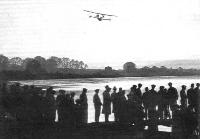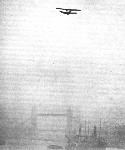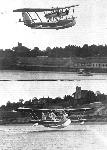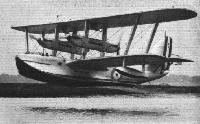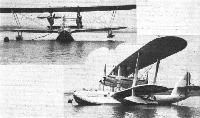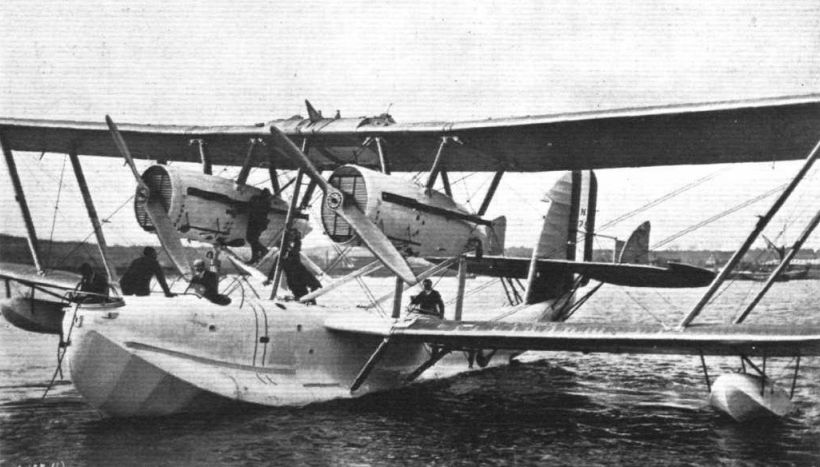
Варианты
- Short - N.3 Cromarty - 1921 - Великобритания
- Short - Singapore I / S.5 - 1926 - Великобритания
- Short - Singapore III / S.19 - 1934 - Великобритания
Short S.5, S.12 и S.19 Singapore I, II и III
Компания "Short Brothers" возлагала большие надежды на самолет S.5 Singapore I, который стал ее первой цельнометаллической летающей лодкой. Этот биплан был разработан на базе самолета Cromarty, имевшего деревянный фюзеляж. Прототип (G-EBUP) был облетан 17 августа 1926 года. Эта машина в серию не пошла, хотя и совершила под управлением Алана Кобхема в период с ноября 1927 года по июнь 1928 года рекордный перелет вокруг Африки протяженностью 37015 км.
Модель S.12 Singapore II успеха тоже не имела.
<...>
Описание:
- Short S.5, S.12 и S.19 Singapore I, II и III
- Flight, July 1929
BRITISH AIRCRAFT AT OLYMPIA - Flight, September 1930
SHORT "SINGAPORE" MARK II
Фотографии
-
Flight 1927-07 / Flight
Регистрационный номер: N179 [4] A NEW ALL-METAL FLYING BOAT: This photograph shows the Short "Singapore" with two Rolls-Royce "Condor" engines. As the machine is a service type (reconnaissance) details may not be published, but the "Singapore," in addition to being all-metal except for the wing covering, is claimed definitely to be able to fly with one engine stopped, even when carrying full load. The freedom from water soakage attained with a metal hull increases the useful load very materially, while the anti-corrosion treatment has now been found very effective, with consequent gain in the life of a machine.
-
Aeroplane Monthly 1989-07 / E.Chilton - The 1927 Baltic 'boat tour
Регистрационный номер: N179 [4] The all-metal Short Singapore N179, powered by two Rolls-Royce Condors. Engine problems delayed its start to Copenhagen until the following day.
-
Aeroplane Monthly 1989-07 / E.Chilton - The 1927 Baltic 'boat tour
Регистрационный номер: N179 [4] THE SERVICE SCANDINAVIAN CRUISE: The one of the four R.A.F. flying-boats which are taking part in a cruise round Scandinavia. The all-metal Short Singapore prototype N179 (two "Condors");
After a false start it completed the 3,000-mile tour without incident, and was later registered G-EBUP for use by Alan Cobham. -
Flight 1928-04 / Flight
Регистрационный номер: G-EBUP [8] THE AFRICAN SURVEY FLIGHT: "Snap" taken en route to the Cape: The Short "Singapore" (Rolls-Royce "Condor") refuelling with Shell.
-
Flight 1939-04 / Flight
Регистрационный номер: G-EBUP [8] The Short Singapore used by Sir Alan Cobham when he made an initial survey of the Cairo-Cape route in 1928 - a picture taken on his return to Rochester.
The Singapore I of 1927 was originally fitted with Rolls-Royce Condors, though Buzzards were eventually substituted. -
Flight 1929-07 / Flight
Регистрационный номер: G-EBUP [8] SHORT "SINGAPORE I" (2 Rolls-Royce "H.10").
-
Flight 1928-06 / Flight
Регистрационный номер: G-EBUP [8] THE END OF A LONG "SHORT" STORY: Sir Alan Cobham's latest big flight, known as the "Sir Charles Wakefield Survey Flight Around Africa," was concluded on June 11, when the Short-Rolls-Royce "Singapore" metal flying-boat was safely moored at Rochester - as shown in the photograph - at the finish of Sir Alan's supplementary stage, the tour of Britain.
-
Flight 1928-02 / Flight
Регистрационный номер: G-EBUP [8] SIR ALAN COBHAM AT MALTA: Our picture shows Sir Alan's Short all-metal "Singapore" flying-boat (Rolls-Royce "Condor" engines) in Valletta Harbour, prior to resuming the flight to Africa on January 21, after an enforced stay of over five weeks.
-
Flight 1928-04 / Flight
THE AFRICAN SURVEY FLIGHT: "Snap" taken en route to the Cape: An "attack" by native war canoes on the Short "Singapore" on Lake Victoria, taken while a film was being "shot" by Mr. Bonnett, the cinematographer of the expedition.
-
Flight 1927-11 / Flight
A CLIPPER OF THE CLOUDS: The Short "Singapore," with two Rolls-Royce "Condor" engines, on which Sir Alan Cobham is starting to-day on his 20,000 miles' flight around Africa, photographed during a test flight over the Medway.
-
Flight 1930-01 / Flight
Sir Alan Cobham is shown flying the Singapore, in which he made a tour round Africa in 1927, accompanied by Lady Cobham. He flew down the Great Lakes, and then round the coast, returning by West Africa, where a flying boat was a most unique sight. No man has done more than Sir Alan Cobham to induce air-mindedness in the people of the British Empire.
-
Flight 1927-11 / Flight
"GOOD BYE AND GOOD LUCK": The Short "Singapore," two Rolls-Royce "Condor" engines, starting on its 20,000-miles flight from Rochester, on November 17.
-
Flight 1927-11 / Flight
THROUGH FOG TO SUNSHINE: The Short "Singapore" flying over London on its way to the coast.
-
Flight 1927-11 / Flight
Регистрационный номер: G-EBUP [8] TESTING THE SHORT "SINGAPORE": These two views show the machine undergoing tests for Sir Alan Cobham, piloted by Mr. Lankester Parker, at Rochester, where the works of Short Brothers are situated. The Wakefield Survey Flight around Africa is scheduled to start on or about November 15.
-
Flight 1927-08 / Flight
Регистрационный номер: N179 [4] 12 августа 1927г.: четыре прототипа летающей лодки покинули Феликстав, взяв курс на порты Балтики, чтобы помочь британским ВВС принять решение, какой из типов самолетов поступит на вооружение. Это были Supermarine Southampton, Blackburn, Short Singapore (фото) и Saunders-Roe Valkyrie.
THE SHORT "SINGAPORE": An all-metal flying boat fitted with two Rolls-Royce "Condor" engines. The machine has many interesting features, apart from its Duralumin construction, but as a service type it may not be described. -
Flight 1927-11 / Flight
Регистрационный номер: G-EBUP [8] THE FLIGHT AROUND AFRICA: Three views of the Short "Singapore" all-metal flying-boat, fitted with two Rolls-Royce "Condor" engines, which will be used by Sir Alan Cobham on his forthcoming 20,000 miles' flight.
-
Flight 1927-12 / Flight
Регистрационный номер: G-EBUP [8] THE WAKEFIELD SURVEY FLIGHT AROUND AFRICA: This photograph of Sir Alan Cobham s Short "Singapore" beached at Malta, gives an indication of the "strafing" which the machine received during the gale. It is an eloquent testimony to the strength of metal construction that in spite of the damage sustained by the lower port wing, the metal hull is perfectly intact. There is little doubt that under similar circumstances a wooden hull would have been wrecked.
-
Flight 1929-08 / Flight Advertisements
The Short "Singapore" Rolls Royce Flying Boat after its 23,000 miles Flight, piloted by Sir Alan Cobham.
-
Flight 1928-06 / Flight
THE SIR CHARLES WAKEFIELD SURVEY FLIGHT AROUND AFRICA: Some snapshots en route. On the left, Sir Alan and Lady Cobham have a peep out of the starboard and port, respectively, rear cockpits of the Short-Rolls-Royce "Singapore," while flying at 100 m.p.h. In the centre (top) the "Singapore" moored at Frisco Lagoon, and (below) Sir Alan "surveying" Africa from the pilot's cockpit in mid-air. On the right is Capt. Worrell, second pilot of the expedition.
-
Flight 1929-07 / Flight
The Short "Singapore" is the machine on which Sir Alan Cobham flew to the Cape and back. A "Mussel" and an amphibian "Moth" are also exhibited.
Другие самолёты на фотографии: De Havilland Gipsy Moth / Moth X - Великобритания - 1928Short Mussel / S.7 - Великобритания - 1926
-
Мировая Авиация 234
Единственный S.12 Singapore II, облетанный в марте 1930 года, был оснащен четырьмя двигателями, установленными парами тандемно, с тянущими и толкающими воздушными винтами. В серию самолет не пошел.
CLEAN RUNNING: The "Singapore" Mark II planing on her step. -
Flight 1930-09 / Flight
THE "SINGAPORE" MARK II: Two views of the machine at rest. Note the small frontal area, and the lower wing root fairings.
-
Flight 1939-04 / Flight
Developments of Singapore I - the Singapore II, with four Rolls-Royce Kestrels.
-
Flight 1926-01 / Flight
This photograph shows the step of the Short all-metal hull flying.boat "Singapore."
-
Flight 1932-06 / Flight
NOT A NEW TYPE OF "MOTH" SEAPLANE: This photograph shows the force-recording undercarriage used at Felixstowe for taxying tests of large-scale models of flying-boat hulls (in this case that of a Short "Singapore II").
-
Flight 1929-07 / Flight
The Short "Singapore" hull construction uses channel and L-section frames. The longitudinal stringers are interrupted at the frames.
-
Flight 1929-07 / Flight
ON THE SHORT "SINGAPORE": Details of the duralumin box spars, strut fittings and a strut end. Note laminated spar flanges.
-
Flight 1929-07 / Flight
Short "Singapore" 2 Rolls-Royce H.10 Engines
- Фотографии









